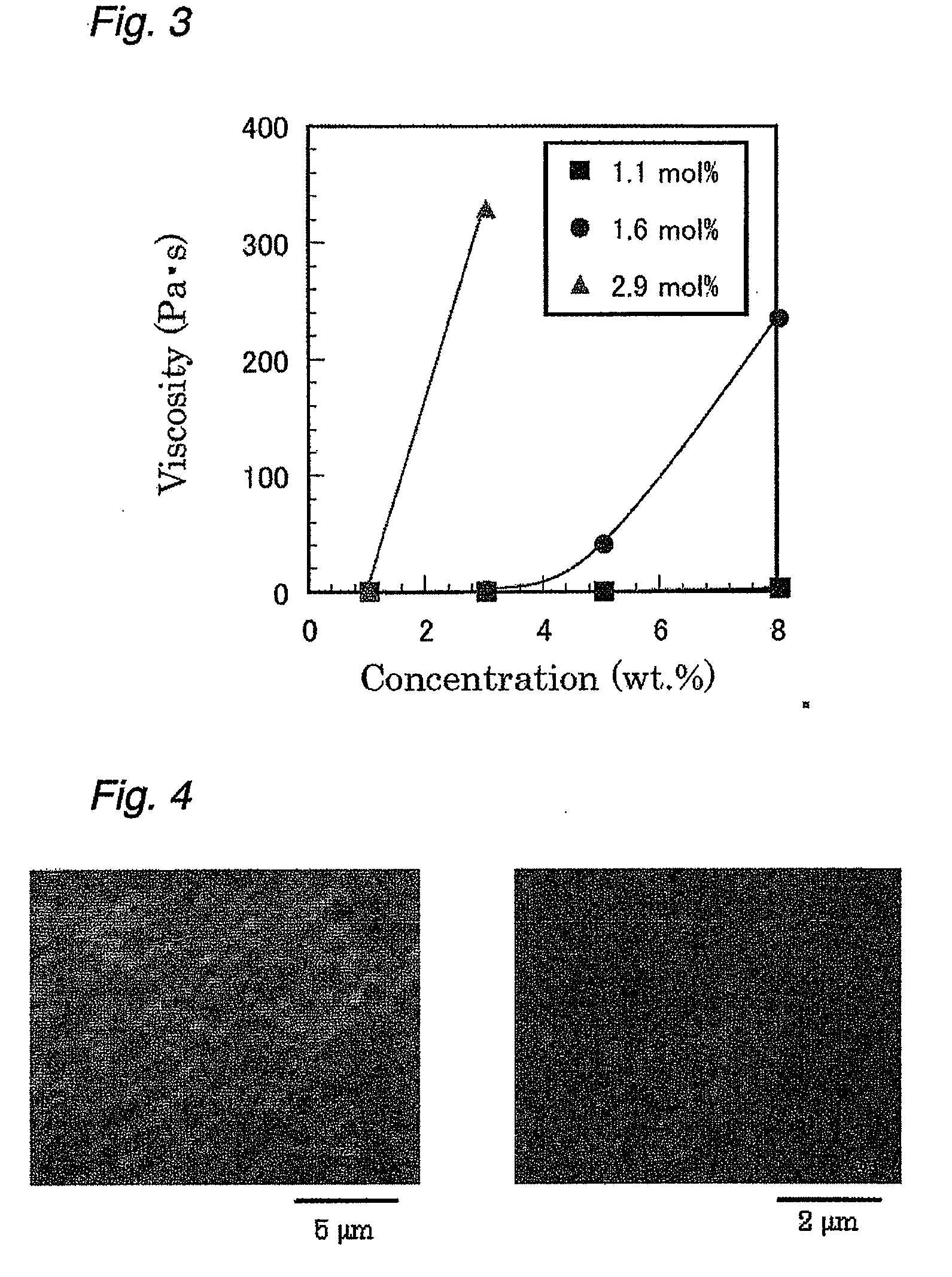Cholesterolamine-introduced poly-gamma-glutamic acid derivative
a polygamma-glutamic acid and cholesterol-introduced technology, applied in the field of polygamma-glutamic acid derivatives, can solve the problems of difficult to use pga as a carrier of medicaments, difficult to process fine particles, and difficult to use fine particles as fine particles
- Summary
- Abstract
- Description
- Claims
- Application Information
AI Technical Summary
Benefits of technology
Problems solved by technology
Method used
Image
Examples
example 1
[0147]The aforementioned PGA in an amount equivalent to 3 mmol as a glutamic acid monomer was dissolved in 10 mL of dimethylsulfoxide (DMSO).
[0148]Further, 0.03 mmol of the aforementioned cholesterolamine (CHAm) was dissolved in 10 mL of tetrahydrofuran (THF).
[0149]The aforementioned PGA solution and the cholesterolamine solution were then mixed with each other. Then, 0.12 mmol of N,N′-carbonyldiimidazole (CDI) was added thereto, and the mixture was stirred at room temperature for 24 hours. After completion of the reaction, THF was removed from the reaction product in a reduced-pressure concentrating apparatus (evaporator), and then rough purification was performed by a reprecipitation process using toluene. Toluene was removed from the rough purification product, and thereafter the resulting rough purification product was neutralized with sodium bicarbonate. The aqueous solution was purified by dialysis using a dialysis membrane having a molecular weight cut-off of 2,000 for 2 days...
example 2
[0155]A test was carried out in a manner similar to Example 1, except that 0.075 mmol of the aforementioned cholesterolamine derivative (CHAm) and 0.3 mmol of the N,N′-carbonyldiimidazole (CDI) were used. As a result, the yield based on the amounts of the PGA and the cholesterolamine derivative used (theoretical yield calculated by assuming that the CHAm used was all introduced into the PGA) was 68%. The cholesterol introduction ratio was 1.6%.
[0156]A 0.05 wt % aqueous solution of the derivative obtained was prepared and processed in a homogenizer for a certain period of time; and particle diameter measurement of the formed fine particles was performed by using a dynamic light-scattering detector (DLS). The data became constant after ultrasonication for approximately 2 minutes, and an average particle diameter of approximately 460 nm was measured. The results are shown in FIG. 1.
[0157]Further, the aqueous solution was left stand for 6 days, and the change in diameter of the fine par...
example 3
[0160]A test was carried out in a manner similar to the aforementioned Example 1, except that 0.15 mmol of the aforementioned cholesterolamine derivative (CHAm) and 0.6 mmol of the N,N′-carbonyldiimidazole (CDI) were used. The resulting cholesterol introduction ratio was 2.9%.
[0161]A 0.05 wt % aqueous solution of the obtained derivative was prepared and processed in a homogenizer for a certain period of time, and particle diameter measurement of the formed fine particle was performed by using a dynamic light-scattering detector (DLS). The data became constant after ultrasonication for approximately 2 minutes, showing that the average particle diameter was approximately 340 nm. The results are shown in FIG. 1.
[0162]The viscosity of the aqueous solution of the derivative obtained was also determined. As a result, it was confirmed that the viscosity increased in a concentration range of 5% or more (FIG. 3).
[0163]The conditions and the results in Examples 1 to 3 are shown in the followi...
PUM
| Property | Measurement | Unit |
|---|---|---|
| diameter | aaaaa | aaaaa |
| particle diameter | aaaaa | aaaaa |
| aggregation | aaaaa | aaaaa |
Abstract
Description
Claims
Application Information
 Login to View More
Login to View More - R&D
- Intellectual Property
- Life Sciences
- Materials
- Tech Scout
- Unparalleled Data Quality
- Higher Quality Content
- 60% Fewer Hallucinations
Browse by: Latest US Patents, China's latest patents, Technical Efficacy Thesaurus, Application Domain, Technology Topic, Popular Technical Reports.
© 2025 PatSnap. All rights reserved.Legal|Privacy policy|Modern Slavery Act Transparency Statement|Sitemap|About US| Contact US: help@patsnap.com



